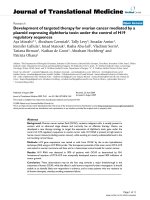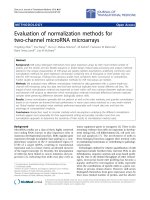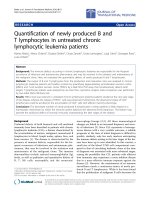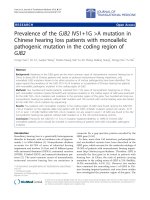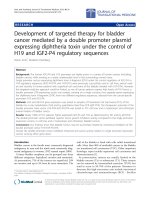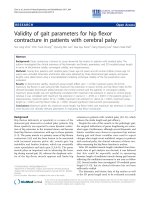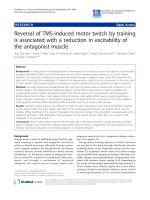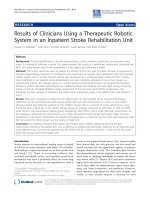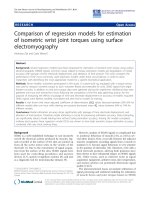Báo cáo hóa học: " Validity of gait parameters for hip flexor contracture in patients with cerebral palsy" pot
Bạn đang xem bản rút gọn của tài liệu. Xem và tải ngay bản đầy đủ của tài liệu tại đây (541.02 KB, 7 trang )
RESEARCH Open Access
Validity of gait parameters for hip flexor
contracture in patients with cerebral palsy
Sun Jong Choi
1
, Chin Youb Chung
2*
, Kyoung Min Lee
2
, Dae Gyu Kwon
2
, Sang Hyeong Lee
3
, Moon Soek Park
2
Abstract
Background: Psoas contracture is known to cause abnormal hip motion in patients with cerebral palsy. The
authors investigated the clinical relevance of hip kinematic and kinetic parameters, and 3D modeled psoas length
in terms of discriminant validty, convergent validity, and responsiveness.
Methods: Twenty-four patients with cerebral palsy (mean age 6.9 years) and 28 normal children (mean age 7.6
years) were included. Kinematic and kinetic data were obtained by three dimensional gait analysis, and psoas
lengths were deter mined using a musculoskeletal modeling technique. Validity of the hip parameters were
evaluated.
Results: In discriminant validity, maximum psoas length (effect size r = 0.740), maximum pelvic tilt (0.710),
maximum hip flexion in late swing (0.728), maximum hip extension in stance (0.743), and hip flexor index (0.792)
showed favorable discriminant ability between the normal controls and the patients. In convergent validity,
maximum psoas length was not significantly correlated with maximum hip extension in stance in control group
whereas it was correlated with maximum hip extension in stance (r = -0.933, p < 0.001) in the patients group. In
responsiveness, maximum pelvic tilt (p = 0.008), maximum hip extension in stance (p = 0.001), maximum psoas
length (p < 0.001), and hip flexor index (p < 0.001) showed significant impr ovement post-operatively.
Conclusions: Maximum pelvic tilt, maximum psoas length, hip flexor index, and maximum hip extension in stance
were found to be clinically relevant parameters in evaluating hip flexor contracture.
Background
Hip flexion deformity or spasticity is a cause of the
abnormal gait observed in cerebral palsy patients. Hip
flexor spasticity was reported to cause dynamic restric-
tion of hip extension in the terminal st ance and become
fixed hip flexion contracture with age in those patients
[1-3]. The psoas muscle is a primary cause of hip flexion
contracture [4,5] and has been known to be a ssociated
with increased anterior pelvic tilt, crouch gait, hip
instability and lumbar lordosis, which can eventually
cause spondylosis and back pain [1,4,6-8]. The psoas
muscle plays an important role in advancing the lower
leg during normal gait [4], whereas the dysphasic activ-
ity of the hip flexor muscle opposes and limits hip
extension in patients with cerebral palsy [4,9-11], which
reduces the stride length and gait efficacy.
Despite the role of t his muscle in t he pathologic gait,
the surgical indications of psoas lengthening are some-
what vague. Furthermore, although several kinematic and
kinetic variables were shown to represent hip motion
during gait and those variables were used to report
changes after single event multilevel surgery in patients
with cerebral palsy, the clinical relevance of those vari-
ables measuring the hip flexor function is unclear.
After 3D modeled muscle length calculated from kine-
matic data of gait analysis was devised, it was believed
that this could be especially useful in measuring
dynamic length of multijoint muscle during gait because
refl ecting the multijoi nt movement is not easy to follow
[12]. Several studies have investigated 3D modeled psoas
length [13-15], but its clinical relevance has not been
sufficiently verified.
The kinematic and kinetic data of hip motion a s well
as the 3D psoas length need to be evaluated accurately
* Correspondence:
2
Department of Orthopedic Surgery, Seoul National University Bundang
Hospital, 300 Gumi-Dong, Bundang-Gu,Sungnam, Kyungki 463-707, Republic
of Korea
Full list of author information is available at the end of the article
Choi et al. Journal of NeuroEngineering and Rehabilitation 2011, 8:4
/>JNER
JOURNAL OF NEUROENGINEERING
AND REHABILITATION
© 2011 Choi et al; licensee BioMed Central Ltd. This is an Open Access article distribu ted under the terms of the Creative Commons
Attribution License ( w hich permits unrestricted use, distribution, and reproduction in
any medium, provided the original work is properly cited.
for clinical use. This study examined the validity of
kinema tic and kinetic variables measuring the hip flexor
function and the 3D modeled psoa s length by 1) discri-
minating the pathologic gait f rom the normal gait (dis-
criminant validity), 2) correlating those variables
(convergent validity), and 3) analyzing post-operative
changes (responsiveness).
Methods
Inclusion/Exclusion Criteria
This retrospective study was performed at a tertiary
referral center for cerebral palsy and was approved by
the institutional review board. The study was designed
to include a group of normal children and a group of
patients with cerebral palsy. For the group of normal
children, volunteers aged from 5 to 15 years old were
recruited. The exclusion criteria were known neuromus-
cular disease and an abnormality of lower limb align-
ment. For the study group, patient selection was based
on the medical records since 1997 . In order to have a
homogenous group of the patients with cerebral palsy,
the following incl usion criteria were used: 1) ambulatory
patients with spastic diplegia (GMFCS level I-II, gross
motor function classification system [16], who had the
representative gait pattern consisting of a jump gait pat-
tern [17] with intoeing, equinus, stiff knee, and femoral
antetorsion, which is one of the most representative gait
patterns of dip lega; 2) patients who underwent bilateral
single event multilevel surgery (bilateral tendo-Achille s
lengthening, distal hamstring lengthening, rectus femoris
transfer, femoral derotational osteotomy); 3) a follow-up
period of more than one year; 4) the pre-operative and
post-operative gait analysis; and 5) 5-15 years of age.
The exclusion criteria were patients with a history of
gait corrective surgery or selective dorsal rhizotomy,
neuromuscular diseases other than cerebral palsy, an
asymmetrical gait pattern and surgical procedures other
tha n the index procedures. The demographic data, phy-
sical examination (including Thomas test [18]), and gait
parameters of the patients, includin g gender, age,
GMFCS level, cadence, step length, and walking speed,
were collected. Informed consent for the retrospective
review of the gait analy sis data of patients and control
group was waived by the institutional review board at
our hospital.
Kinematic and kinetic data
The gait analysis laboratory was equipped with a Vicon
370 (Oxford Metrix, Oxford, UK)systemconsistingof
seven CCD cameras and two force plates. Motion was
captured while the subjects walked barefoot on a nine-
meter walkway, and the kinematic and kinetic data were
obtained, which were averaged by three trials. The hip
flexion and extension, hip rotation, and pelvic tilt were
the key kinematic variables. T he kinetic data including
time of crossover in the hip flexion-extension moment
and the power burst of hip flexor in the late stance were
obtained. The hip flexor index was calculated from the
kinematic and kinetic data of the hip and pelvic moti on,
which were maximum pelvic tilt, pelvic tilt range, maxi-
mum hip extension in stance, and late stance power
burst of hip joint (H3) [19].
3D modeled psoas length
The psoas length was obtained using interacti ve muscu-
loskeletal modeling [20] software (SIMM, Motion Analy-
sis Corporation, Santa Rosa, CA) (Figures 1 and 2). The
psoas length was determined to be between the muscu-
lar origin and insertion, which were the transverse pro-
cess of the lumbar spine and lesser trochanter of the
femur, respectively. However, in this study, spine motion
was not included. Calculated average psoas origin was
used, and calculated average pelvic brim was used as via
Figure 1 Three dimensional musculoskeletal modeling image
depicting the psoas muscles between their bony origins and
insertions with the knee and hip joint in 0° of extension, which
represents static psoas length.
Choi et al. Journal of NeuroEngineering and Rehabilitation 2011, 8:4
/>Page 2 of 7
points. The anatomic points were calculated from the
kinemat ic data of fe mur and pelvis. Although psoas is a
multijoint muscle, only hip angles were reflected in its
length. The psoas length was standardized by dividing
the calculated psoas length during gait by the muscle
length when the subjects were in a simulated anatomic
position. This standar dized psoas leng th was recorded
continuously during the gait cycle (Figure 3) and
included for analysis.
Validity of kinematic and kinetic variables, and psoas
length in hip flexor function
There are no gold standards for measuring hip flexor
function during gait. Therefore, the validity of kinematic
and kinetic data regarding hip flexor function relies on
the content validity and construct validity. Construct
validity is comprised of the discriminant validity and
convergent validity. The discriminant validity [21] is one
facet of the construct validi ty, and reflects the degree to
which an instrument can distinguish between or among
different concepts or constructs [22]. This is the ability
to detect clinically relevant difference. In this study,
effect-size r [23] between the normal control and th e
patient groups were assessed as in previous studies
[24-27]. Convergent validity [21,28] which is another
type of construct validity, occurs when the scales of a
measurement correlate as expected with the related
scales of another measurement. In this study, the 3D
modeled psoas lengths wer e compared with the kine-
matic and kinetic hip parameters representing hip and
pelvic mo tion. Responsiveness [29] was tested by com-
paring the pre-operative and post-operative variables.
Statistical Analysis
One of the principal variables in this study was the
psoas length on which we had few previous studies that
we could refer to. We assumed that 1% of difference in
psoas length between the control and patient groups
would be c linically relevant, and prior power analysis
(alpha error 0.05, power 0.8) revealed that over 17 sub-
jects would be needed on each group. The average of
the variables of right and left legs were used for data
analysis to ensure data independence.
Statistical analysis was performed using SPSS Ver. 15.0
(SPSS, Chicago , Illinois). The normal distribution of the
data was t ested using a Kolmogorov-Smirnov test. The
discriminant validity was assessed by the effect-size r
[23] for the kinematic and kinetic variables and psoas
length. The Effect size is a name given to a famil y of
indices that measures the magnitude of a certain effect
and is generally measured in two ways: as the standar-
dized difference between two means, or as the correla-
tion between the in dependent variable classification
and individual scores on the dependent variable.
Figure 2 Psoas length (distance between its bony origin and
insertion) changed throughout the gait cycle, which is
dynamic psoas length.
Figure 3 Standardized psoas length was calculated and
depicted throughout the gait cycle, which is dynamic psoas
length divided by static psoas length.
Choi et al. Journal of NeuroEngineering and Rehabilitation 2011, 8:4
/>Page 3 of 7
This correlation is called the effect size correlation
(ef fect-size r) and was used for the discriminant validity
in this study. Correlations between each of the kine-
matic and kinetic variables and psoas length were ana-
lyzed using a Pearson’s correlation test for convergent
validity. The comparison of the data between the
patients and normal controls was performed using a
t-test, and the post-operative changes in the patients
were analyzed using a paired t-test. A p value < 0.05
was considered significant. For multiple testing, statisti-
cal significance was adjusted for family wise error.
Results
Twenty-four patients with cerebral palsy were finally
included in this study. The mean age of the patients was
6.9 years (SD 1.6 years), and there were 15 males and
9 females. The GMFCS levels were I in 15 patients and
II in 9 patients. The mean age of the 28 normal controls
was 7.6 ye ars (SD 2.4 years), and there were 17 males
and 11 females. The mean age and gender ratio w ere
not significantly different between the two groups (p =
0.222 and p = 0.973) (Table 1).
Discriminant validity of kinematic and kinetic data, and
psoas length
The discriminant validity between the patients and nor-
mal control group was highest in hip flexor index (effect
size r = 0.792) followed by maximu m hip ext ension in
stance (0.743), maximum psoas length (0.740), maxi-
mum hip flexion in late swing (0.728) and maximum
pelvic tilt (0.710). Kinetic data, including the ti me of
crossover in hip flexion-extension moment (0.059) and
power burst of hip flexor in late stance (0.020), showed
an unsatisfactory discriminant validity (Table 2).
Convergent validity of kinematic and kinetic data, and
psoas length
In the normal control group, the correlation coefficient
between the maximum psoas length and maximum
hip extension in stance was -0.420 (p = 0.065). The
maximum psoas length showed correlation coefficients
of 0.601, -0.651, and -0.448 with the step length, time of
crossover in hip flexion-extension moment, and hip
flexor index, respectively. The minimum psoas length
showed no significant correlation with the kinematic
and kinetic variables (Table 3).
In the patients gro up, the maxi mum psoas leng th
showed a significant correlation with the maximum hip
extension in stance (r = -0.933, p < 0.001). The correla-
tion coeffici ent between the maximum psoas length and
hip flexor index was -0.467 (p = 0.001). There was no
significant correlation between the maximum psoas
length and step length (Table 4). Thomas test did not
show significant correlation with maximum psoas length
in control and patient groups.
Responsiveness of kinematic and kinetic data,
and psoas length
The maximum pelvic tilt, maximum hip extension in
stance, max imum psoas length a nd hip flexor index
showed significant improvement after surgery (p =
0.008, p = 0.001, p < 0.001, and p < 0.001 respec-
tively). There was no signi ficant post-operative change
in the range of psoas lengths (p = 0.158) and power
Table 1 Demographic data and gait parameters
Patients Normal controls p
N2428
Age (years) 6.9 (1.6) 7.6 (2.4) 0.222
Sex (M:F) 15:9 17:11 0.973
Follow up period (years) 1.1 (0.2) -
GMFCS level (I/II) 15/9 -
Gait parameters
Cadence (No./min) 101.2 (14.2) 112.5 (12.9) 0.001
Step length (cm) 35.3 (6.2) 53.0 (9.2) <0.001
Walking speed (cm/s) 59.9 (13.5) 99.9 (16.9) <0.001
Data are presented as mean (SD).
Table 2 Discriminant validity of hip parameters
Cerebral
palsy
Normal
controls
p Effect
size (r)
Thomas test (°) 7.4 (6.8) 0.6 (1.9) <0.001 0.561
Pelvic tilt (°)
maximum 21.9 (4.9) 12.1 (4.8) <0.001 0.710
minimum 12.6 (5.9) 6.9 (3.9) 0.008 0.497
range 9.4 (3.5) 5.2 (2.5) 0.002 0.562
mean 17.5 (5.1) 9.5 (4.1) <0.001 0.654
Max hip extension in
stance (°)
-0.5 (6.1) 11.1 (4.2) <0.001 0.743
Max hip flexion in late
swing (°)
50.4 (5.9) 38.2 (5.5) <0.001 0.728
Hip rotation (°)
maximum 12.8 (8.2) 12.8 (9.9) 0.997 0.005
minimum 0.2 (9.2) -11.8 (13.2) 0.005 0.467
range 12.6 (4.1) 24.7 (11.5) 0.009 0.573
mean 6.3 (8.9) 0.1 (10.0) 0.086 0.308
Psoas length (%)
maximum 99.2 (1.3) 101.5 (0.8) <0.001 0.740
minimum 87.5 (1.4) 90.4 (1.7) <0.001 0.684
range 11.7 (1.5) 11.1 (1.2) 0.126 0.212
mean 93.6 (1.3) 96.0 (1.3) <0.001 0.676
TOC (%) 28.2 (11.5) 27.0 (8.6) 0.767 0.059
H3 (W/kg) 0.3 (0.4) 0.3 (0.4) 0.920 0.020
HFI 5.9 (1.4) 1.9 (1.7) <0.001 0.792
TOC, time of cross over in hip flexion/extension moment; H3, late swing
power burst in hip joint flexion/extension power; HFI, hip flexor index.
Data are presented as mean (SD).
Choi et al. Journal of NeuroEngineering and Rehabilitation 2011, 8:4
/>Page 4 of 7
burstofthehipflexorinlatestance(p=0.627)
(Table 5).
Discussion
The patients with cerebral palsy s howed a shorter psoas
length and smaller maximum hip extension in stance
than the normal control group. The maximum psoas
length was found to refle ct the kinetic and kinematic
data of hip motion. The hip flexor index showed satis-
factory discriminant and convergent validity, showing a
significant correlation with the psoas length. The result
of the cross correlation revealed an excellent correlation
between the maximum ps oas length and maximu m hip
extension in the patients group (Table 6).
The patients wit h cerebral palsy showed a shorter
maximum psoas length, larger pelvic tilt, and more
sagittal pelvic motion than the normal control gro up.
The maximum hip extension in stance was limited in
the patient group, which was possibly caused by a
Table 3 Correlation coefficients between psoas length
and gait parameters in control group
Max PL Min PL Range PL Mean PL
Thomas test (°) -0.253 -0.416* 0.407* -0.450*
Pelvic tilt (°)
maximum -0.576* -0.206 0.050 -0.399
minimum -0.595* -0.141 -0.018 -0.296
range -0.110 -0.140 0.108 -0.240
mean -0.672* -0.226 0.044 -0.420
Max hip extension in
stance (°)
-0.420 -0.029 -0.082 -0.201
Max hip flexion in late
swing (°)
-0.312 -0.327 0.238 -0.302
Hip rotation (°)
maximum 0.140 -0.098 0.133 -0.172
minimum -0.316 -0.101 0.015 -0.233
range 0.532* 0.012 0.128 0.088
mean -0.128 -0.091 0.055 -0.226
TOC (%) -0.651* -0.085 -0.107 -0.344
H3 (W/kg) 0.140 -0.305 0.326 -0.234
HFI -0.448* -0.081 -0.039 -0.269
Cadence (No./min) -0.278 -0.208 0.131 -0.288
Step length (cm) 0.601* 0.206 -0.044 0.355
Walking speed (cm/s) 0.511* 0.149 -0.011 0.232
TOC, time of cross over in hip flexion/extension moment; H3, late swing power
burst in hip joint flexion/extension power; HFI, hip flexor index; *, p < 0.05.
Table 4 Correlation coefficients between psoas length
and gait parameters in patients group
Max PL Min PL Range PL Mean PL
Thomas test (°) -0.116 0.408* -0.476* 0.200
Pelvic tilt (°)
maximum -0.331* -0.611* 0.326* -0.610*
minimum -0.446* -0.474* 0.109 -0.547*
range 0.286* -0.054 0.268 0.069
mean -0.457* -0.560* 0.182 -0.635*
Max hip extension in
stance (°)
-0.933* -0.299* -0.427* -0.747*
Max hip flexion in late
swing (°)
-0.137 -0.740* 0.596* -0.585*
Hip rotation (°)
maximum -0.367* -0.445* 0.142 -0.495*
minimum -0.388* -0.423* 0.105 -0.442*
range 0.098 -0.003 0.077 -0.072
mean -0.369* -0.421* 0.117 -0.450*
TOC (%) -0.324* -0.183 -0.090 -0.417*
H3 (W/kg) 0.135 0.004 0.106 0.009
HFI -0.467* -0.503* 0.120 -0.646*
Cadence (No./min) -0.133 -0.001 -0.100 -0.109
Step length (cm) 0.101 -0.074 0.147 -0.122
Walking speed (cm/s) 0.040 -0.022 0.051 -0.122
TOC, time of cross over in hip flexion/extension moment; H3, late swing power
burst in hip joint flexion/extension power; HFI, hip flexor index; *, p < 0.05.
Table 5 Responsiveness of psoas length and gait
parameters in patients with spastic diplegia
Pre-operative Post-operative p
Pelvic tilt (°)
maximum 21.9 (4.9) 18.8 (4.9) 0.008
minimum 12.6 (5.9) 12.9 (5.0) 0.897
range 9.4 (3.5) 5.9 (2.1) <0.001
mean 17.5 (5.1) 15.9 (4.9) 0.126
Max hip extension in
stance (°)
-0.5 (6.1) 4.6 (7.5) 0.001
Max hip flexion in late
swing (°)
50.4 (5.9) 42.9 (5.1) <0.001
Hip rotation (°)
maximum 12.8 (8.2) 10.0 (4.9) 0.107
minimum 0.2 (9.2) -5.2 (7.0) 0.016
range 12.6 (4.1) 15.3 (4.6) 0.015
mean 6.3 (8.9) 2.3 (5.8) 0.051
Psoas length (%)
maximum 99.2 (1.3) 100.3 (1.2) <0.001
minimum 87.5 (1.4) 89.3 (1.6) <0.001
range 11.7 (1.5) 11.1 (1.9) 0.158
mean 93.6 (1.3) 95.0 (1.2) <0.001
TOC (%) 28.2 (11.5) 24.6 (12.3) 0.173
H3 (W/kg) 0.3 (0.4) 0.5 (2.0) 0.627
HFI 5.9 (1.4) 3.8 (2.0) <0.001
Cadence (No./min) 101.2 (14.2) 103.0 (16.6) 0.251
Step length (cm) 35.3 (6.2) 41.1 (6.2) <0.001
Walking speed (cm/s) 59.9 (13.5) 71.1 (15.8) <0.001
TOC, time of cross over in hip flexion/extension moment; H3, late swing
power burst in hip joint flexion/extension power; HFI, hip flexor index.
Data are presented as mean (SD).
All patients underwent bilateral femoral derotation osteot omy, rectus femoris
transfer, distal hamstring lengthening, and tendo-Achilles lengthening as
single event multilevel surgery.
Choi et al. Journal of NeuroEngineering and Rehabilitation 2011, 8:4
/>Page 5 of 7
shorter psoas length. However, the range of psoas
lengths was similar in the patients and control group
suggesting that muscle excursion was not significantly
different. The kinetic variable, including the time of
crossover in the hip flexion-extension moment and
the power burst of the hip flexor in late stance, were
similar in the patients and controls. In this study, the
maximum psoas length, hip flexor index and sagittal
pelvic motion showed favorable discriminant validity.
The correlation coefficient between the maximum
psoas length and maximum hip extension in stance
was -0.420 (p= 0.065) in the control group whereas it
was -0.933 in the patients (p < 0.001). The shortened
maximum psoas length in the patients appeared to
limit the maximum extension of the hip joint. How-
ever, the maximum psoas length might not have been
the limiting factor in maximum hip extension in the
control group. This could have cause different corre-
lation coefficients of the two groups between maxi-
mum psoas length and maximum hip extension in
stance.
It has been reported that the psoas length could be
confounded by the femoral anteversion [30], which is
supported by the results of this study. The psoas length
incre ased post-operatively, even t hough no psoas proce-
dures had been performed in addition to femoral dero-
tation osteotomy. Therefore, femoral derotation
osteotomy may improve the dynamic psoas length possi-
blybymovingthelessertrochanterforward.However,
this requires further examination.
Thi s study had some limit ations. First, although small
changes in the kinetic and kinematic variables in the
study were statistically significant, they may h ave been
due to marker placement variability, despite this being
performed by a single experienced operator. Second, the
3D psoas length did not reflect the lumbar spinal
motion which could affect the real psoas length signifi-
cantly because the model did not contain the trunk
marker sets. Therefore, the 3D modeled psoas length
might not be as accurate as expected.
Conclusions
The patients with cerebral palsy showed a shorter psoas
length than the normal control group. The hip flexor
index and psoas length showed good discriminant validity.
There was an excellent correlation between the maximum
psoas length and maximum hip extension in the patients
group. There was evidence that estimated psoas length
could be improved after femoral derotation osteotomy,
even though no psoas procedure had been performed.
Acknowledgements
The authors wish to thank Seon Boo, BS and Myoung Yl Park, BS for the
technical support and advice, and Mi Sun Ryu for collecting the data. This
study was conducted at Seoul National University Bundang Hospital. There
was internal funding for this study from Seoul National University Bundang
Hospital (SNUBH research fund 02-2008-030).
Author details
1
Department of Orthopedic Surgery, Synergy Hospital, 115-17 Nonhyun-
Dong, Kangnam-Gu, Seoul, 135-010, Republic of Korea.
2
Department of
Orthopedic Surgery, Seoul National University Bundang Hospital, 300 Gumi-
Dong, Bundang-Gu,Sungnam, Kyungki 463-707, Republic of Korea.
3
Department of Orthopedic Surgery, Dongguk University Ilsan Hospital, 814
Siksa-Dong, Ilsandong-Gu, Koyang, Kyungki 410-773, Republic of Korea.
Authors’ contributions
CYC, MSP, and KML have made substantial contributions to conception and
design. SJC, DGK, and SHL have been involved in acquisition of data,
analysis and interpretation of data. SJC, KML and MSP drafted the
manuscript. All authors read and approved the manuscript.
Competing interests
The authors declare that they have no competing interests.
Received: 20 May 2010 Accepted: 23 January 2011
Published: 23 January 2011
References
1. Bleck EE: Postural and gait abnormalities caused by hip-flexion deformity
in spastic cerebral palsy. Treatment by iliopsoas recession. J Bone Joint
Surg Am 1971, 53:1468-1488.
2. Dostal WF, Andrews JG: A three-dimensional biomechanical model of hip
musculature. J Biomech 1981, 14:803-812.
3. Feldkamp M, Denker P: Importance of the iliopsoas muscle in soft-tissue
surgery of hip deformities in cerebral palsy children. Arch Orthop Trauma
Surg 1989, 108:225-230.
4. Bialik GM, Pierce R, Dorociak R, Lee TS, Aiona MD, Sussman MD: Iliopsoas
tenotomy at the lesser trochanter versus at the pelvic brim in
Table 6 Validity of the parameters for hip flexor contracture
Discriminant validity
(effect-size r)
Convergent validity in normal
control (correlation r)
Convergent validity in CP
(correlation r)
Responsiveness
(effect-size r)
Maximum pelvic tilt
(°)
**** *** ** **
Max hip extension in
stance (°)
**** *** ***** **
HFI **** *** *** ***
Maximum psoas
length (%)
**** ††***
HFI, hip flexor index.
*, 0-0.2; **, 0.2-0.4; ***, 0.4-0.6; ****, 0.6-0.8; *****, 0.8-1.0.
†, convergent validity was the correlation coefficient with maximum psoas length.
Choi et al. Journal of NeuroEngineering and Rehabilitation 2011, 8:4
/>Page 6 of 7
ambulatory children with cerebral palsy. J Pediatr Orthop 2009,
29:251-255.
5. Matsuo T, Hara H, Tada S: Selective lengthening of the psoas and rectus
femoris and preservation of the iliacus for flexion deformity of the hip
in cerebral palsy patients. J Pediatr Orthop 1987, 7:690-698.
6. Harada T, Ebara S, Anwar MM, Kajiura I, Oshita S, Hiroshima K, Ono K: The
lumbar spine in spastic diplegia. A radiographic study. J Bone Joint Surg
Br 1993, 75:534-537.
7. Hoffer MM: Management of the hip in cerebral palsy. J Bone Joint Surg
Am 1986, 68:629-631.
8. Houkom JA, Roach JW, Wenger DR, Speck G, Herring JA, Norris EN:
Treatment of acquired hip subluxation in cerebral palsy. J Pediatr Orthop
1986, 6:285-290.
9. Zwick EB, Saraph V, Zwick G, Steinwender C, Linhart WE, Steinwender G:
Medial hamstring lengthening in the presence of hip flexor tightness in
spastic diplegia. Gait Posture 2002, 16:288-296.
10. Sutherland DH, Zilberfarb JL, Kaufman KR, Wyatt MP, Chambers HG: Psoas
release at the pelvic brim in ambulatory patients with cerebral palsy:
operative technique and functional outcome. J Pediatr Orthop 1997,
17:563-570.
11. Morais Filho MC, de Godoy W, Santos CA: Effects of intramuscular psoas
lengthening on pelvic and hip motion in patients with spastic diparetic
cerebral palsy. J Pediatr Orthop 2006, 26:260-264.
12. Delp SL, Arnold AS, Piazza SJ: Graphics-based modeling and analysis of
gait abnormalities. Biomed Mater Eng 1998, 8:227-240.
13. Schutte LM, Hayden SW, Gage JR: Lengths of hamstrings and psoas
muscles during crouch gait: effects of femoral anteversion. J Orthop Res
1997, 15:615-621.
14. Delp SL, Arnold AS, Speers RA, Moore CA: Hamstrings and Psoas lengths
during normal and crouch gait: implications for muscle tendon surgery.
J Orthop Res 1996, 14:144-151.
15. Van der Krogt MM, Doorenbosch CA, Harlaar J: Muscle length and
lengthening velocity in voluntary crouch gait. Gait Posture 2007,
26:532-538.
16. Palisano R, Rosenbaum P, Walter S, Russell D, Wood E, Galuppi B:
Development and reliability of a system to classify gross motor function
in children with cerebral palsy. Dev Med Child Neurol 1997, 39:214-223.
17. Rodda JM, Graham HK, Carson L, Galea MP, Wolfe R: Sagittal gait patterns
in spastic diplegia. J Bone Joint Surg Br 2004, 86:251-258.
18. Thomas HO: Diseases of hip, knee, and ankle joints, wIth their
deformities, treated by new and efficient method. Liverpool: Dobb; 1876.
19. Schwartz MH, Novacheck TF, Trost J: A tool for quantifying hip flexor
function during gait. Gait Posture 2000, 12:122-127.
20. Delp SL, Loan JP, Hoy MG, Zajac FE, Topp EL, Rosen JM: An interactive
graphics-based model of the lower extremity to study orthopaedic
surgical procedures. IEEE Trans Biomed Eng 1990, 37:757-767.
21. Campbell DT, Fiske DW: Convergent and discriminant validation by the
multitrait-multimethod matrix. Psychol Bull 1959, 56:81-105.
22. Jewell DV: Guide to Evidence-based physical therapy practice. Sudbury:
Jones & Bartlett Learning;, 2 2010.
23. Cohen J: Statistical power analysis for the behavioral sciences. Hillsdale,
NJ, Lawrence Earlbaum Associates;, 2 1988.
24. Stouthard MEA, Hoogstraten J, Mellenbergh GJ: A study on the
convergent and discriminant validity of the dental anxiety inventory.
Behav Res Ther 1995, 33:589-595.
25. Quinnell FA, Hynan MT: Convergent and discriminant validity of the
perinatal PTSD questionnaire (PPQ): A preliminary study. J Traumatic
Stress 1999, 12:193-199.
26. Sagi A, Van IJzendoorn MH, Scharf M, Koren-Karie N, Joels T, Mayseless O:
Stability and Discriminant validity of the adult attachment interview:
A psychometric study in young Israeli adults. Dev Psychol 1994,
30:771-777.
27. Westen D, Rosenthal R: Quantifying construct validity: Two simple
measures. J Pers Soc Psychol 2003, 84:608-618.
28. Ware JEJ, Snow KK, Kosinski M, Gandek B: SF-36 Health Survey Manual
and Interpretation Guide. Boston; USA, New England Medical Center; 1993.
29. Staquet MJ, Hays RD, Fayers PM: Quality of life assessment in clinical
trials. New York, Oxford Unversity Press; 1998.
30. Schutte LM, Hayden SW, Gage JR: Lengths of hamstrings and psoas
muscles during crouch gait: effects of femoral anteversion. J Orthop Res
1997, 15:615-621.
doi:10.1186/1743-0003-8-4
Cite this article as: Choi et al.: Validity of gait parameters for hip flexor
contracture in patients with cerebral palsy. Journal of NeuroEngineering
and Rehabilitation 2011 8:4.
Submit your next manuscript to BioMed Central
and take full advantage of:
• Convenient online submission
• Thorough peer review
• No space constraints or color figure charges
• Immediate publication on acceptance
• Inclusion in PubMed, CAS, Scopus and Google Scholar
• Research which is freely available for redistribution
Submit your manuscript at
www.biomedcentral.com/submit
Choi et al. Journal of NeuroEngineering and Rehabilitation 2011, 8:4
/>Page 7 of 7
